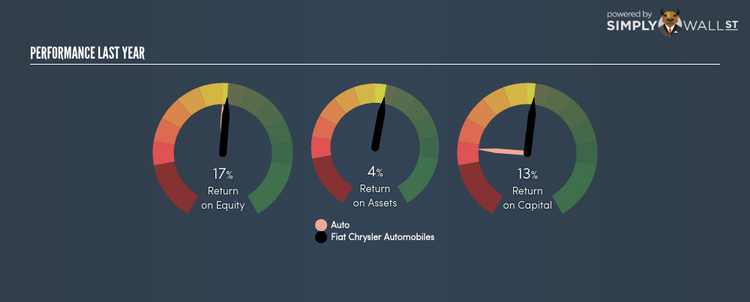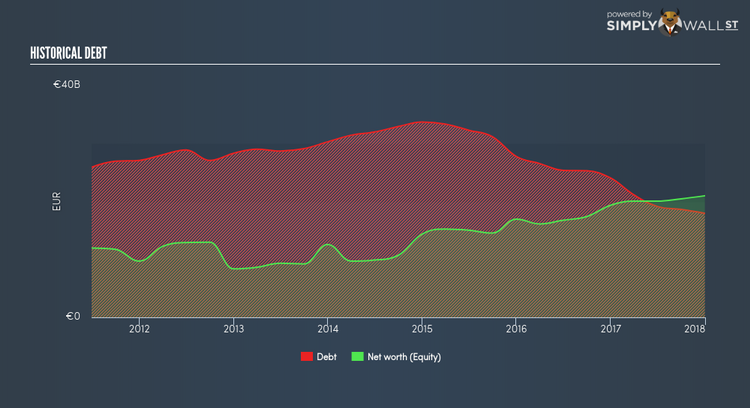Should You Expect Fiat Chrysler Automobiles NV. (BIT:FCA) To Continue Delivering An ROE Of 16.73%?

Fiat Chrysler Automobiles NV. (BIT:FCA) delivered an ROE of 16.73% over the past 12 months, which is an impressive feat relative to its industry average of 15.96% during the same period. Superficially, this looks great since we know that FCA has generated big profits with little equity capital; however, ROE doesn’t tell us how much FCA has borrowed in debt. In this article, we’ll closely examine some factors like financial leverage to evaluate the sustainability of FCA’s ROE. View our latest analysis for Fiat Chrysler Automobiles
Breaking down ROE — the mother of all ratios
Firstly, Return on Equity, or ROE, is simply the percentage of last years’ earning against the book value of shareholders’ equity. It essentially shows how much the company can generate in earnings given the amount of equity it has raised. While a higher ROE is preferred in most cases, there are several other factors we should consider before drawing any conclusions.
Return on Equity = Net Profit ÷ Shareholders Equity
ROE is measured against cost of equity in order to determine the efficiency of Fiat Chrysler Automobiles’s equity capital deployed. Its cost of equity is 11.39%. This means Fiat Chrysler Automobiles returns enough to cover its own cost of equity, with a buffer of 5.34%. This sustainable practice implies that the company pays less for its capital than what it generates in return. ROE can be broken down into three different ratios: net profit margin, asset turnover, and financial leverage. This is called the Dupont Formula:
Dupont Formula
ROE = profit margin × asset turnover × financial leverage
ROE = (annual net profit ÷ sales) × (sales ÷ assets) × (assets ÷ shareholders’ equity)
ROE = annual net profit ÷ shareholders’ equity
Essentially, profit margin shows how much money the company makes after paying for all its expenses. Asset turnover shows how much revenue Fiat Chrysler Automobiles can generate with its current asset base. And finally, financial leverage is simply how much of assets are funded by equity, which exhibits how sustainable the company’s capital structure is. Since ROE can be inflated by excessive debt, we need to examine Fiat Chrysler Automobiles’s debt-to-equity level. Currently the debt-to-equity ratio stands at a reasonable 85.63%, which means its above-average ROE is driven by its ability to grow its profit without a significant debt burden.
Next Steps:
ROE is one of many ratios which meaningfully dissects financial statements, which illustrates the quality of a company. Fiat Chrysler Automobiles exhibits a strong ROE against its peers, as well as sufficient returns to cover its cost of equity. Its high ROE is not likely to be driven by high debt. Therefore, investors may have more confidence in the sustainability of this level of returns going forward. Although ROE can be a useful metric, it is only a small part of diligent research.
For Fiat Chrysler Automobiles, there are three fundamental factors you should further examine:
Financial Health: Does it have a healthy balance sheet? Take a look at our free balance sheet analysis with six simple checks on key factors like leverage and risk.
Valuation: What is Fiat Chrysler Automobiles worth today? Is the stock undervalued, even when its growth outlook is factored into its intrinsic value? The intrinsic value infographic in our free research report helps visualize whether Fiat Chrysler Automobiles is currently mispriced by the market.
Other High-Growth Alternatives : Are there other high-growth stocks you could be holding instead of Fiat Chrysler Automobiles? Explore our interactive list of stocks with large growth potential to get an idea of what else is out there you may be missing!
To help readers see pass the short term volatility of the financial market, we aim to bring you a long-term focused research analysis purely driven by fundamental data. Note that our analysis does not factor in the latest price sensitive company announcements.
The author is an independent contributor and at the time of publication had no position in the stocks mentioned.


